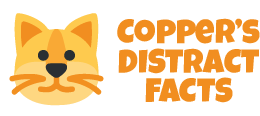Scrumptious Skunks for Supper
Many birds don’t have a great sense of smell, and sometimes their meal choices confirm it. Crows don’t mind eating a little carrion, which is the rotting flesh of another animal who has already met its end.
Great horned owls munch on a little carrion too, but they take smelly refreshments to another level. They love to eat skunks. There aren’t many other predators who will snack on those stripy sprayers of stinky stuff. Any animal that can eat a skunk will have no problem sharing a bus seat with a funky goat.

When you look, you see. But you might need to hold your nose.
Great horned owls will be the first to tell you that a stink don’t smell when you don’t smell so well. Still, you probably don’t want to be anywhere near a great horned owl eating a skunk. But you can check out Copper’s Distract Fact about great horned owls and their ear tufts to find some hints for locating great horned owls in general.
Here is another tip that might prove useful to you. Sometimes you can find owls by looking down. How? Owls cough up owl pellets, little furry balls of undigested material which may pile up below a typical roosting spot. If you find the owl pellets by day, you can come back in the evening and often find the owl who made the pellets. To learn more about owl pellets, check out the BirdNote link in the next section.

Hoping to get a whiff of more info about owls and their sometimes stinky meal choices?
Even if you aren’t a great horned owl, the book and websites below don’t stink!
Kids, remember to ask a parent, teacher, or librarian for help whenever you are looking for books or using the Internet. I always try to make sure to share kid-friendly books and resources, but websites are changing all the time, so always check with an adult first.
- You can never have enough books on owls around the house, and a great one to have handy is The Complete Book of North American Owls by James Duncan. You’ll learn all about the characteristics, habits, and hunting techniques of all sorts of owls. Plus, it is loaded with beautiful pictures of the owls as adults and juveniles. Check with your librarian or a local bookstore to grab a copy.
- Visit Audubon’s Field Guide entry for Great Horned Owls for details on how they feed, what they eat (hint: just about everything, including skunks), and where they like to eat. https://www.audubon.org/field-guide/bird/great-horned-owl
- Ever wondered what happens to the fur and bones after an owl eats an animal like a mouse? Well, the owl packages it up into a nice little bundle called an owl pellet, and then coughs it up. If that sounds like something you have an appetite to learn more about, scarf up this short BirdNote podcast story about owl pellets. https://www.birdnote.org/show/examining-owl-pellets
